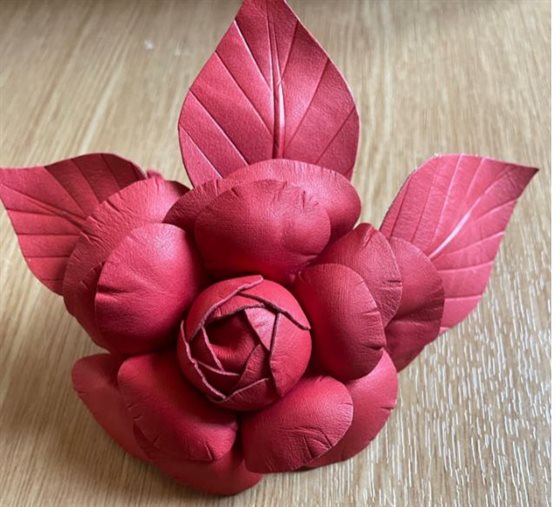An award-winning couture milliner has given her support to a De Montfort University Leicester (DMU) project which aims to champion sustainable materials and promote heritage crafts.
Guila Mio, based at Maker’s Yard in the city, has run her own luxury millinery businesses for more than 12 years. Giulia came to DMU to share her bespoke hand making skills with students to create flora and fauna in leather, who are part of the university’s Artifacts Live: A Legacy of Leather project.
The project is a collaboration with the Museum of Leathercraft and DMU.
The MoL has loaned some of its most precious artifacts, some of which date back centuries as inspiration for the students involved in the Artifacts Live project. Some of the selected pieces will be displayed at the DMU Museum from October this year, alongside new work by students inspired by the artifacts.
Throughout, students have been learning centuries old hand techniques which will allow them to develop their knowledge of working with and creating new pieces from recycled, deadstock and sustainably-sourced leather.
Each student has chosen two pieces from the museum’s donated collection, which includes a 19th century framed diorama, of flowers and animals created in leather.

Guila’s bespoke hats often feature her exquisite silk and hand-painted flowers, which she makes from silk and leather. During an all-day workshop at Trinity Chapel she took students through the process of creating a flower similar to those seen in the 19th century design.
She said: “You can make quite detailed pieces the texture from leather is so different to fabric, the versatility of it is quite astonishing. I feel like these skills, although they exist, they are getting less and less common.
“What DMU and the Museum of Leathercraft are doing is very good. We need to support awareness of the importance of craftspeople and these skills, and show people how beautiful things can be. There is a value in keeping these skills alive.”

Students who took part in the workshop said they thoroughly enjoyed the experience and had learned new skills.
Fine art student Martha Lavery has been inspired to create an installation for the upcoming exhibition, designing and making a chair and using linocut prints. She said: “I’m really enjoying it. I’m learning new things all the time. I am planning on making a chair and printing the design to the fabric that will cover it.
“Because I’m fine art, I’ve never thought about fashion and design and being part of this project has actually made me think of new options after university.”
Contour Fashion final year student Imogen Sullivan is basing her final collection on black bridalwear and is planning on using leather in her designs.
“My designs are for tailored, sophisticated bridalwear and I want to use what I have learned today to make leather roses that are really delicate and intricate. Having the class with Guila was incredible, just being able to watch her work and talk about the process has been so good. Her pieces are so high end and I think it shows just how versatile leather is as a material.
“The artifacts are amazing and I’m loving being part of this project. I’ve never seen anything like the pieces from the museum the level of skill is incredible.”

The calf skin leather, utilised in the highest quality gloves, was donated to the project by project partners Pittards, Somerset - who also supply Giulia for her couture millinery business.
Associate Professor Gillian Proctor, Faculty Enterprise Lead, has been working with the Museum of Leathercraft and the Worshipful Company of Leathersellers for years connecting students with the organisations.
She said: “For centuries the wider fashion industry has been applauded globally for its bespoke hand-crafted skills in all areas of embellishment, decoration and resolutions. Giulia’s exquisite millinery is a fine example of work being produced in small ateliers all across the UK which highlights sumptuous materials, considered design and astonishing results unlike anything you can buy on a commercial basis.
“Giulia was delighted to view the artifacts as inspirational for her own work, in particular, the diorama which is reminiscent of the intricate wood carvings by Dutch sculptor Grinling Gibbons, in the 17C which can be seen in Windsor Castle and locally at Chatsworth House.
“During covid we saw a massive upsurge in hand crafted skills: knitting, lace making, embroidery, weaving, etc many of which were prevalent in early school years for some generations but sadly lacking now. I was lucky to be taught to sew, knit and embroider by generations of my family, and have loved inspiring the students to address these directives within the project.
“If we are not mindful, we are in danger of losing forever these incredible bespoke skills for generations to come as well as small but dedicated museums not dissimilar to the Museum of Leathercraft. Never has there been such a unprecedented interest in archives, bespoke crafting skills and new museum directives, Hopefully, through this project we will address all three.”
ask jas
Posted on Friday 2 June 2023